| Srl | Item |
| 1 |
ID:
156052
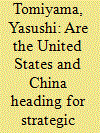

|
|
|
| 2 |
ID:
173099


|
|
|
| 3 |
ID:
132553
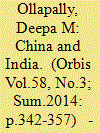

|
|
|
|
|
| Publication |
2014.
|
| Summary/Abstract |
How well do theories of economic interdependence and structural realism explain the India-China divergence between growing economic relations and continuing strategic mistrust? This article looks at the Indian side and argues that we need to go beyond economic and strategic factors, and brings in a more contingent approach based on domestic elite discourse and thinking. The article suggests that a more nuanced and complex debate on China is emerging in India than that posited by interdependence or realism, a debate that is framed by what I term nationalist, realist and globalist schools of thought, with the latter two groups currently holding the center of gravity.
|
|
|
|
|
|
|
|
|
|
|
|
|
|
|
|
| 4 |
ID:
169113
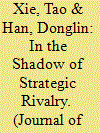

|
|
|
|
|
| Summary/Abstract |
While much has been written about US–China strategic rivalry, no study to the authors’ knowledge has conducted an empirical analysis of this rivalry. This article fills this gap by investigating whether and how this rivalry affects a country’s response to the Asian Infrastructure Investment Bank (AIIB). The findings of this article indicate that certain aspects of bilateral strategic ties indeed have strong effects on a country’s reaction to the Chinese bank. More specifically, shorter distance to higher a level of partnership with, and more arms purchase from Beijing lead to faster accession to the AIIB, while the shorter distance to Washington results in slower accession, controlling for other factors. In addition, economically developed countries appear to be consistently more eager to join the Beijing-led bank than economically underdeveloped countries.
|
|
|
|
|
|
|
|
|
|
|
|
|
|
|
|
| 5 |
ID:
156582
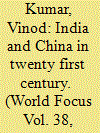

|
|
|
|
|
| Summary/Abstract |
In this era of globalisation each nation depends upon others in terms of economic as well as security cooperation. No state can leave in isolations. India and China are the major emerging economic power with a large chunk of human resource and a huge market in Asia.
|
|
|
|
|
|
|
|
|
|
|
|
|
|
|
|
| 6 |
ID:
125496
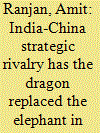

|
|
|
|
|
| Publication |
2013.
|
| Summary/Abstract |
Has China replaced or is an the process of "replacing" strategic presence of India in South Asia, is the most pertinent question, which keeps the Indian strategic community busy. It is known fact that since ancient time South Asia, as a region, had been under the influence of India; but things change since beginning of the Cold War.
|
|
|
|
|
|
|
|
|
|
|
|
|
|
|
|
| 7 |
ID:
099115
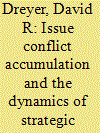

|
|
|
|
|
| Publication |
2010.
|
| Summary/Abstract |
Although states at times contend over a single issue (such as territory), international rivals often contend over multiple issues simultaneously. Issue conflicts tend to accumulate among rivals due to the development of enemy images of the "other," which causes states to view as threatening, behavior that was previously viewed as non-threatening. Once multiple issues are on the agenda, issues become linked as states begin to view the "other" as the main problem in settling all disagreements. Issue accumulation also increases the stakes of rivalry, which likely increases the probability that states will choose to bear the costs of engaging in militarized conflict seeking the settlement of issues in one's favor. An examination of strategic rivals supports the expectations that issue conflict accumulation tends to increase the likelihood of militarized disputes and war. The results also reveal that some paths of issue accumulation, in which certain types of issues come under contention, tend to be more dangerous than others.
|
|
|
|
|
|
|
|
|
|
|
|
|
|
|
|
| 8 |
ID:
137496
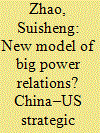

|
|
|
|
|
| Summary/Abstract |
Exploring the causes of the China–US strategic rivalry and its possible mitigation, this article argues that President Xi's new model of big power relations represents a challenge to the US primacy in the Asia–Pacific based on China's rising power and deeply rooted suspicion of the US containment. But neither the US nor China can be the single dominant power in the region. The new model can be built only if China and the US demonstrate a strategic restraint and maintain a delicate balance of power to prevent their rivalry from boiling over into a new Cold War.
|
|
|
|
|
|
|
|
|
|
|
|
|
|
|
|
| 9 |
ID:
161562
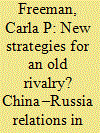

|
|
|
|
|
| Summary/Abstract |
China and Russia both have interests in bordering Central Asia. China's thirst for energy has seen its footprint expand rapidly in the region relative to that of Russia, Central Asia's historical hegemon. With the two powerful neighbors’ history of competition and conflict, the shift in relative influence between them risks a resurgence of bilateral rivalry. Referencing the scholarly literature on strategic rivalry, this article examines how energy relations have helped shaped the trajectory of China-Russian relations in Central Asia, particularly after the shock that came with the collapse of oil and gas prices in 2008–2009.
|
|
|
|
|
|
|
|
|
|
|
|
|
|
|
|
| 10 |
ID:
167637
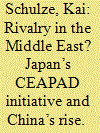

|
|
|
|
|
| Summary/Abstract |
Ever since the so-called rise of China has started, Sino-Japanese relations have been increasingly described as a rivalry between both states. For the most part, this assumed rivalry has been analyzed on the global level or within the boundaries of the East Asian region, while the consequences of this rivalry for other world regions, such as the Middle East, have been largely neglected in the literature. In order to fill this gap, this article investigates how China’s growing presence in the Middle East, and in particular regarding the Israeli-Palestinian conflict, influences Japan’s own foreign policy in this troubled region. It utilizes a modified concept of the strategic rivalry approach, called ‘asymmetric rivalry’, which challenges the widespread notion that rivalry needs to be mutually perceived by both sides and thus analyzes the assumed Sino-Japanese rivalry in the Middle East from a Japanese perspective. By focusing on the case of Japan’s CEAPAD initiative, which aims at coordinating East Asian countries’ developmental assistance towards the Palestinian Authority while deliberately excluding China, the present article shows that the perception of Japan’s foreign policy elite of China as a rival decisively influences how Japan’s foreign policy is shaped in the context of the Israeli-Palestinian conflict.
|
|
|
|
|
|
|
|
|
|
|
|
|
|
|
|
| 11 |
ID:
174791
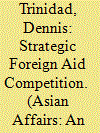

|
|
|
|
|
| Summary/Abstract |
This study examines the Sino-Japanese strategic foreign aid competition in the Philippine infrastructure sector. It argues that the practice of geoeconomics in East Asian affairs has intensified as a result of China's rise as a great-power competitor and the growing nexus of security and economics in the region. In order to make their foreign aids attractive, Japan has adopted a set of normative principles that are encapsulated in its “Quality Infrastructure” as a strategy, while China continues to emphasize the principles of Chinese aid and the adoption of the BRI. The article found, among other outcomes, that the existing maritime dispute between the Philippines and China affects the legitimacy and attractiveness of Chinese assistance. On the other hand, due to their deepening bilateral relation, Japan remains the Philippines's most important bilateral development partner.
|
|
|
|
|
|
|
|
|
|
|
|
|
|
|
|
| 12 |
ID:
179149
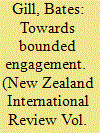

|
|
|
|
|
| Summary/Abstract |
Bates Gill discusses the new normal for US-China relations and what it means for the rest of the world.
|
|
|
|
|
|
|
|
|
|
|
|
|
|
|
|